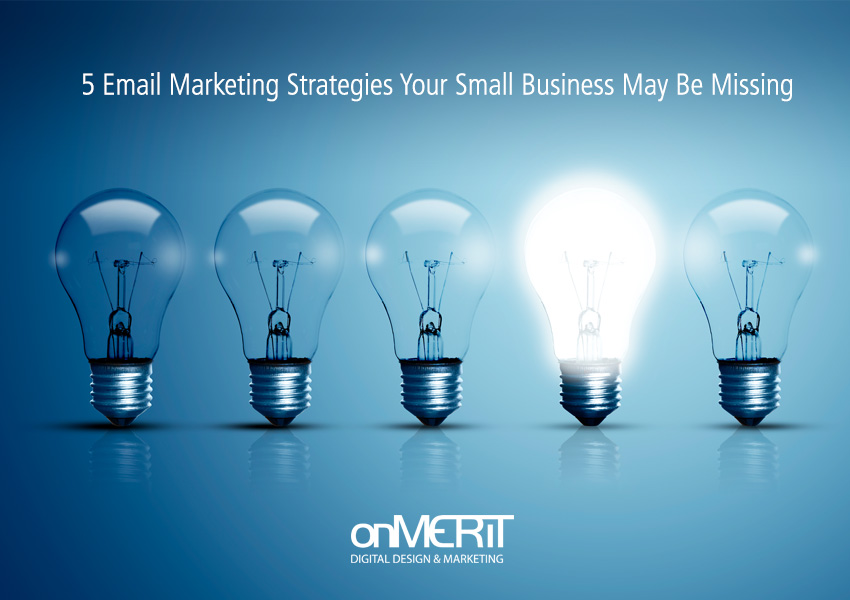5 Email Marketing Strategies Your Small Business May Be Missing
Over the last 20 years, email marketing has become one of the most popular marketing strategies for small businesses. With the the advent of social media there has been a slow shift with more and more companies relying on social media networks like Twitter, Facebook and Instagram for their online marketing needs.
While the social media channels do have their place in your marketing, the reality is that email marketing consistently delivers the strongest ROI of all of the marketing channels.
While social media may seem like the best option as it’s free compared with an email marketing system, the old adage “you get what you pay for” rings very true in this case.
In a 2016 study conducted by Campaign Monitor, they uncovered some highly compelling statistics that illustrate that email marketing is still the way to go:
- There are 3x more email accounts than there are Facebook and Twitter accounts combined.
- An email message is 5x more likely to be seen than if it was posted on Facebook.
- You are 6x more likely to get a click through on email than on Twitter.
Why Email Marketing?
It’s important to keep in mind email is a direct line to a list of people who WANT to hear from you. They have told you that you can contact them so they are already interested.
In 2016, WBR Digital conducted a survey of 254 retailers in the US and according to the data, 81% and 80% of respondents, respectively, said email marketing drives customer acquisition and retention.
Plus, when you build an email list, you own that contact information. With a social media channel, you may have thousands of followers, but if that channel goes away tomorrow, you’re out of luck.
From a cost standpoint, email marketing has one of the best returns on investment of any marketing channel. A 2016 email marketing industry census conducted by Adestra showed that email marketing outperforms search engine optimization, content marketing, paid searches and affiliate marketing.
Finally, one of the absolute best things about email marketing is the data. Email marketing can tell you everything from user interest based on what they click on to open rates, bounce rates and conversion rates. Having the ability to see hard numbers on the effectiveness of a campaign is incredibly valuable.
A key benefit of having this data available is that it allows you to continue the conversation in a more targeted way after the initial email by using a sequence of follow up emails tailored for their interests.
Being able to see what is working and what isn’t in real-time can make the difference between amarketing campaign being a huge success or a complete flop.
If you don’t already have an email marketing strategy for your small business, now is the time to reconsider. (And if you have an email list that needs a some TLC, you’ll want to read this too.)
Here are five email marketing strategies your small business should consider adding:
#1. Offering a Free Opt-in Gift on Your Website
We all want clients and potential clients to visit our websites…but what happens once they are actually there? Having good traffic to your site is awesome, but what you really want is to get their email address so you can keep the conversation going.
One of the goals of your website should be to convert your visitors to subscribers so you can communicate with them regularly and nurture them into doing business with you.
By having something to offer that is of interest or value to them, a free “gift” of some kind, you are enticing them to hand over their precious email address. It means you now have the opportunity to reach out to them long after they have left your site.
The free “gift” can be anything from a helpful checklist related to something with your services to one-time discount on a product or service. The idea is that people need to be wooed a little so you need a compelling offer to get them to subscribe to your list.
#2. Welcoming Subscribers With An Email Nurture Sequence
Your prospective customer has signed up for your email list with an opt-in gift. But now what? This is the time they are most excited and you have their attention so you need what’s called a nurture sequence.
A nurture sequence is series of emails designed to introduce them to you and your business. This helps engage your new subscribers quickly. (You definitely don’t want to have one email that delivers their opt-in gift and they never hear from you again!)
Your nurture sequence is designed to build on the opt-in gift and add value to your subscriber. So think about what they need to know, what they’d like to learn and how you can be helpful.
The idea of the nurture sequence is to establish a relationship. Your sequence should NOT be solely focused on selling products and service, but more on building trust with potential future clients.
At the end of the sequence, you can include an invitation for your subscriber to learn more, work with you or even purchase your product or service.
#3. Delivering Ongoing Value Added Content
Visitors come to your site looking for something. Whether they are just browsing or looking for specific information, they came there for a reason.
So what better time to capitalize on that interest and get their information for future communications?
For example, someone who reads your blog posts will very likely provide their email address when they are being offered even more content that is of interest to them. This can be done by creating an opt-in gift related to your blog content that adds even more value. This can be as simple as a guide or a checklist that builds on what they’ve learned in the post.
This is what is called a “content upgrade” as you’re offering a way for your reader to upgrade their experience with even more value-added content.
Content upgrades are a great way to use a “call to action” to build your list. As if someone has read your blog post to the end, they are clearly interested in what you have to say.
These can be added to the end of blog posts using tools such as PopUp Ally which allow you to add these sign up boxes throughout your website.
#4. Segment Your Email List for Better Targeting
If you’ve had any exposure to email marketing, you know that managing your email list can be your biggest nightmare.
On the one hand, having a robust email list is fantastic, but the problem is that more often than not it’s actually just a giant jumble of email addresses with no real delineation in terms of the subscriber’s interests or other specific details.
The end goal of your email list should always be to send out information to right people at the right time.
This is where segmentation comes in. By using certain email providers such as ConvertKit or Infusionsoft you’re able to “tag” your subscribers with specific information you determine.
With tagging you’re able to segment your email list based on lead status, demographics, location, and other data.
Best of all, when you add tags to different segments of your subscriber list, you’re able to communicate in a way that’s smart and serving your subscriber’s needs.
Once you actually have your list tagged and segmented, you now also have the opportunity to not just target information, but also target offers to different subscriber types. Instead of just sending an email blast to everyone on the list, you’ll be able to look at your subscribers and thoughtfully make an offer for their specific needs.
#5. Consistent Email Communication
One place where you may find an opportunity to make the most of email marketing is with the consistency and frequency of your communications with your subscribers.
Having an email list is only powerful for your marketing and sales if you’re consistently delivering value to your subscribers. This can be done via a monthly, bi-weekly or even weekly email update to your subscribers.
Your “newsletter” or regular emails shouldn’t just focus on selling your product or services, but instead you want to provide a mix of content to your subscribers. starting with simple “check in” emails or newsletters. Some examples you can consider:
- Updates on what’s new with your business
- Educational content such as blog posts
- Events or activities coming up
- Exciting news on the horizon
- Upcoming changes
- Upcoming offers or promotions
Following a regular, predictable schedule for your email communications means your subscribers know when they will hear from you and will begin to expect to be kept up-to-date, which is exactly what you want.
Email marketing has endless potential when it comes to small businesses. As a small business, you don’t have the same constraints as a huge company and this means you can easily adapt and change strategies as your email marketing plans evolve. By adding even just one or two of these strategies you will be on the path to meeting your business goals.
About the Author
Gary is OnMerit Marketing’s owner and blog writer. A Brand Designer and Internet Marketing Specialist, he has a passion for helping small businesses look great and grow their businesses online. Follow Gary on Twitter @onmerit, or Facebook: www.facebook.com/onmeritmarketing




